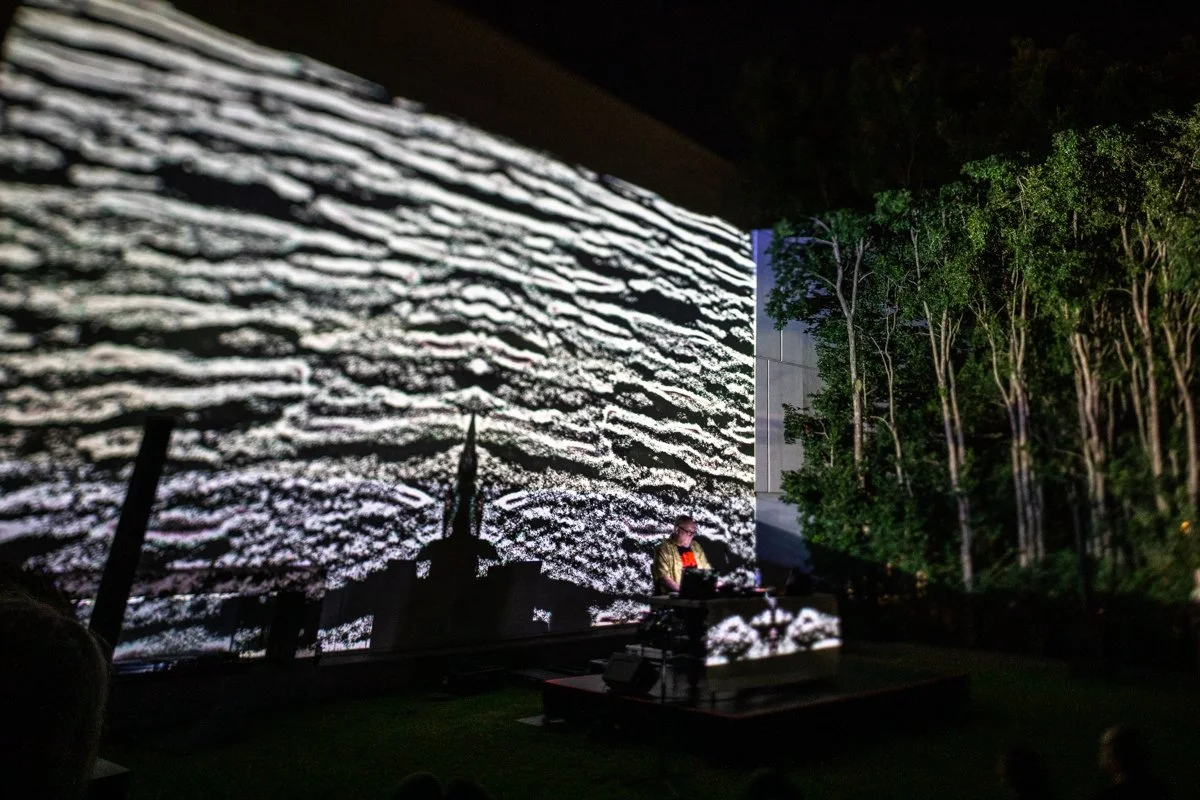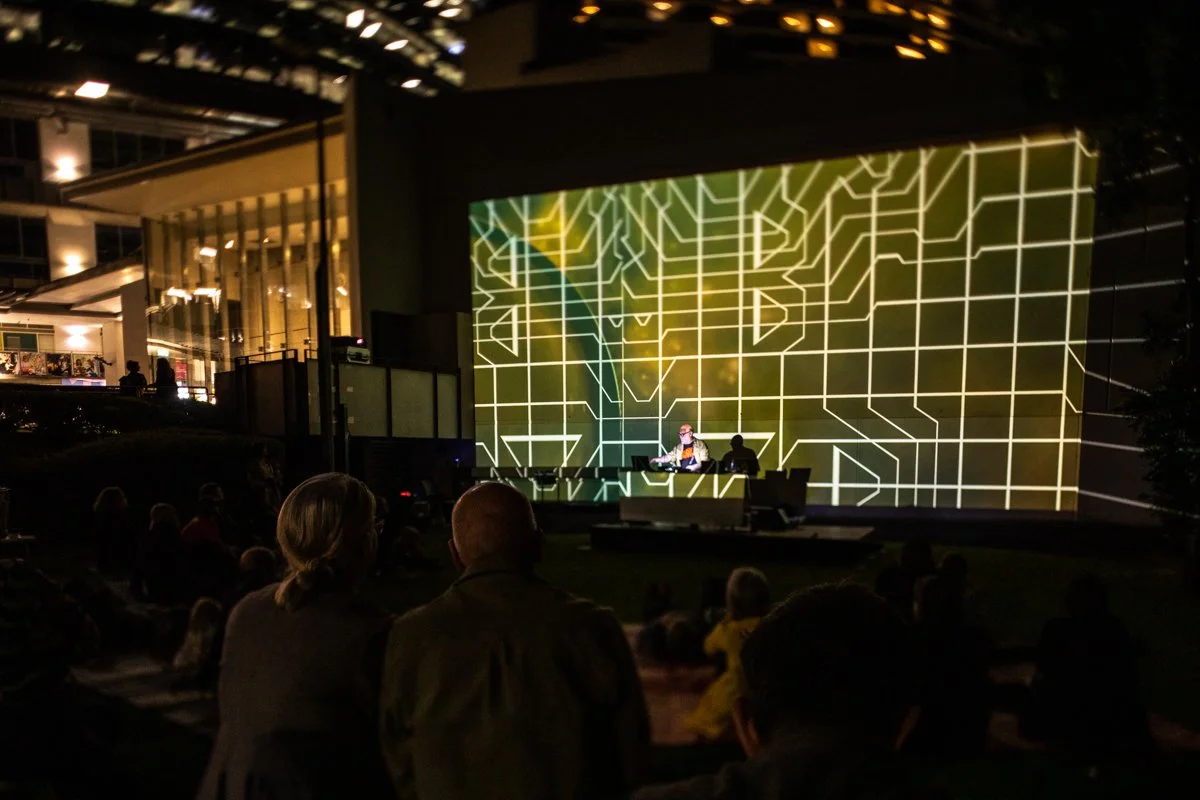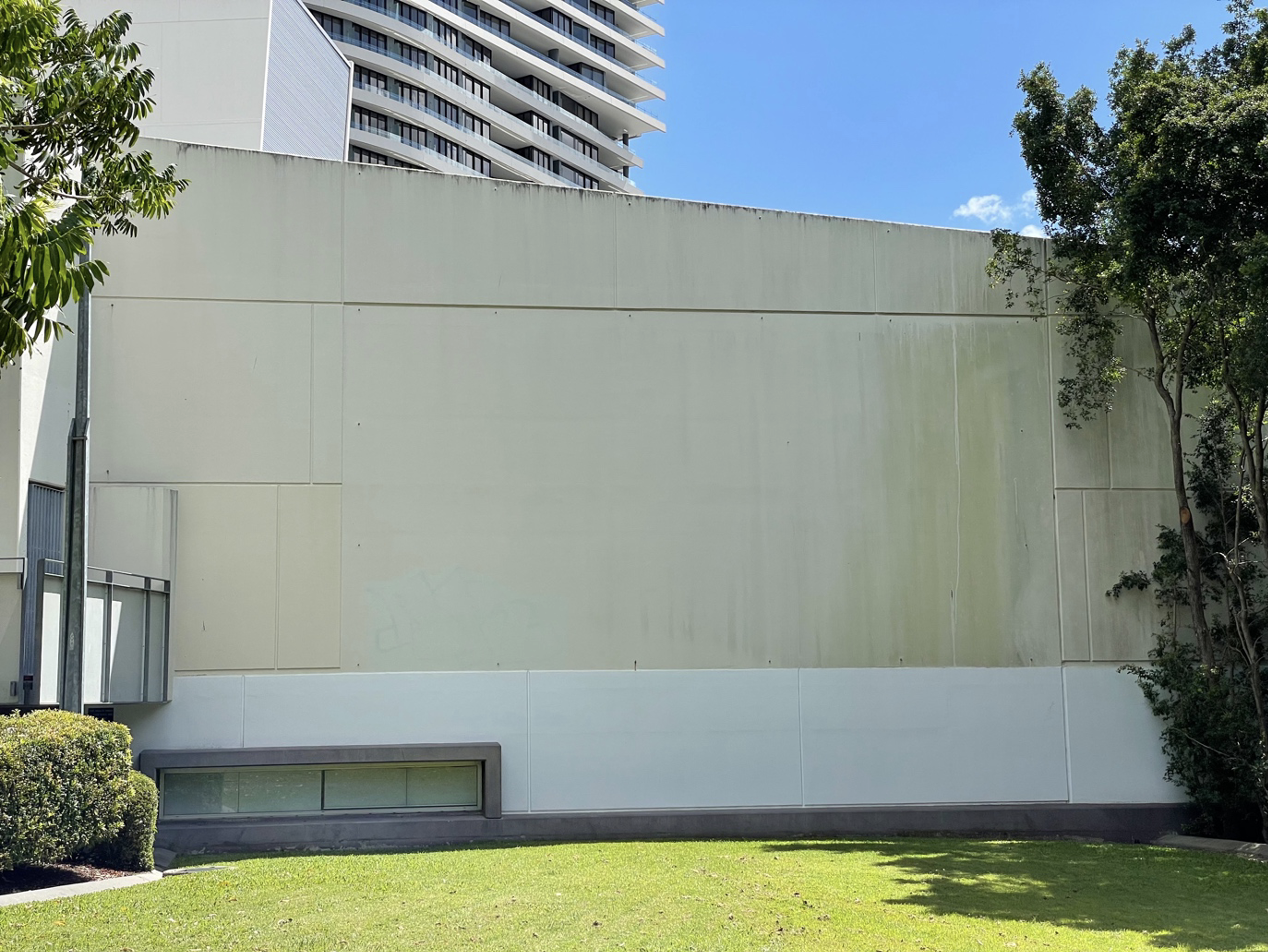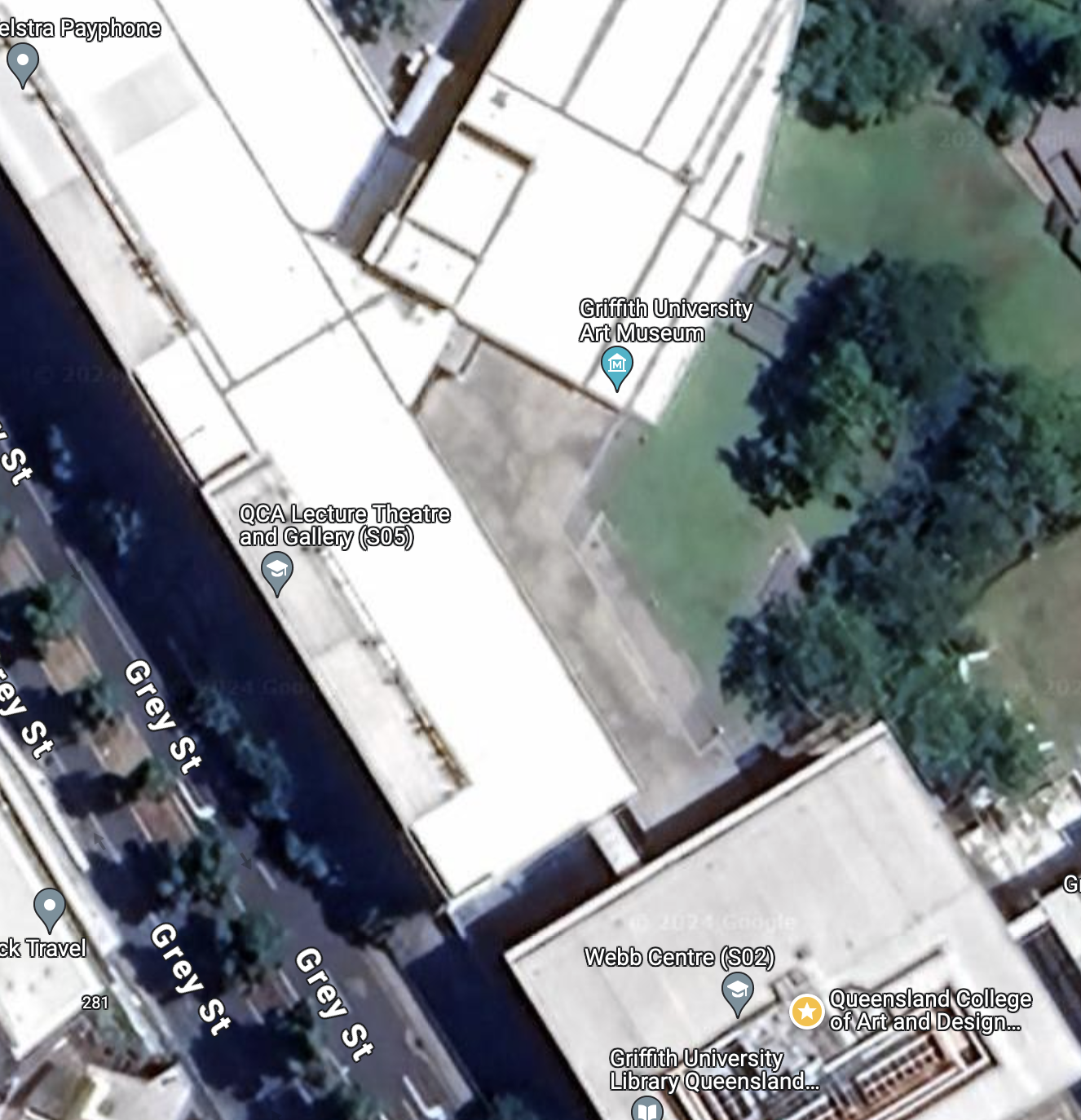peter thiedeke
image maker
Bones–a proposal for ISEA 2024
This video illustrates the development work-in-progress of Bones in the White Box projection lab at South Bank
The work involves experimentation with a trombone's form, scale and spatial aspects. The imagery and sound combine pre-recorded and live generative digital audio-visuals.
Prospective outdoor locations for Bones at South Bank
The S03 Laneway
For the duration of the festival: The Laneway off 226 Grey St. can be activated nightly over extended periods.
GUAM exterior
For an evening of performance: The exterior of GUAM (Griffith University Art Museum) is suitable for a one night performance with live VJ and musical performances–see below.
The exterior of GUAM
The images (below) illustrate how an activation at GUAM will look. These images were taken on the evening of the CARI (Creative Research Institute) launch of Future Projections. This collaborative evening of live performances by CARI artists and researchers featured Tim Gruchy performing his work Alethic.
More about Future Projections
More detail about Bones
Extract from the ISEA 2024 proposal by Chris Stover, John Ferguson and Peter Thiedeke
BONES: UNRAVELING KEY THEMES
[1] experience
We begin by using a “real world” prompt to consider how manipulations of scale and context can change our relationship with and experience of our own perception. We refer to this as the rupture of an object, transforming it into an audiovisual world, or in other words, the rupture of ordinary experience and its transformation into extraordinary experience. Our ordinary object is one of the simplest of musical technologies, the trombone, with its one moving part (the slide, operated by the performer’s right hand/arm) and interlaced axes of sound production: a “horizontal” axis of microtonal possibilities as the slide extends or retracts, and a “vertical” axis of the harmonic series that can be produced at any point along the slide axis. We extend this basic framework with a transgressive audiovisual agenda that looks to rupture the received wisdom that so often defines a musical instrument and its sounding: how can ordinary experience be transformed via changes in scale and form, intensity and direction of motion, sound and sonorous capacities, and redirection of expectation?
[2] space, sound, time, and technologies
Using digital manipulation to break or bend temporal and spatial rules is a key theme. What, we might ask, is “supposed” to happen when we enter into the sonic (and spatial) world of an instrument like the trombone? And what else, then, can potentially happen when we turn to more speculative practices? In this project a responsive multimedia environment built in TouchDesigner is deployed alongside a range of digital audio and video workflows. This work addresses a number of important questions about the nature of trans-media interaction, including especially what kinds of creative possibilities are afforded by the very nature of the interactive medium, which fundamentally blurs the distinction between cause and effect.
[3] resistance
But there’s a third step, which returns to acoustic instruments themselves as sites of resistance. The object is never gone, it is worlded—it becomes-world—just as the complex interplay between being-human and becoming-posthuman seems to be the operative condition of our own existence under late capitalism. The tactile, material nature of an acoustic instrument, in some important way, escapes both the accelerationist impulses of (especially digital) technological innovation and the latter’s tendency to break down at the most opportune moments. This work plays at that ontological-political gap, extending the affordance-possibilities of the instrument through innovative technological enhancement, while always keeping present the conditions within which a ‘post-trombone’ could be developed in the first place.
DESCRIPTION
In imagining how a physical object becomes an audiovisual world, rather than a thing, the overall goal is to transform ordinary experience into an extraordinary one; the relationship between the object and the space, is blurred. We begin by amplifying human presence via an emphasis on breath and breathing (sound and rhythm), then deploy a range of sonic and moving image technologies to reimagine the history of a specific instrument and the culturally received memories and expectations of that instrument. The focus is on bending perception; reaching (forward and back) into our individual consciousnesses to elicit the idiosyncratic and experimental resonances that we all carry with us. The projected image installation forms an immersive spatial image and soundscape. The work creates illusory physics. The imagery emerges from and disappears through corners into an imaginary void behind them, implying a new and potentially infinite existential space (please refer to the documentation video). In an outdoor context, notions of placemaking are foregrounded, and the work offers urban acupuncture, precise and focused interventions with city infrastructure that aim to establish a consciousness of the city’s systems to create new energy and demonstrate the possibilities of space to understand better what might be missing in a particular place. Rather than a utilitarian experience of the city, the work offers an experience of existential freedom. In this world, imagination, thoughts, emotions, dreams, and unconscious memories of the past fuse with the present, and the mental and material worlds fuse in the mind.
This project queries culturally ingrained expectations of an instrument. To do so, they operate along what we call transversal temporal and spatial axes. The temporal axis points backward toward the instrument’s genealogy and the kinds of musical-cultural striations that have marked its performance-practice history, all of which color how one might hear it today (“art is an act of memory,” as the call for this conference puts it). It also points forward toward novel practices: what new sounds are possible, and what residues of old sounds remain present in their enactment (or what kinds of limitations that enabled old sounds can be overcome in what ways, including through the technological manipulation of a “post-trombone”)? The spatial axis operates transversally: how can size and scale be manipulated, with what kinds of expressive or cognitive effects? The trombone is a directional instrument: sound fans out in one direction from the bell; changes in pitch are produced by extending the slide in the same direction (among other techniques). What happens to one’s experience of the trombone when, for example, produced sounds are captured and physically and/or temporally displaced within a performance environment? What happens experientially when those sounds are digitally processed such that their very identity as trombone sounds becomes hard to determine?
THE TROMBONE
In this project we re-begin with two foundational material ideas: breath as an elemental human life-function (which is also how sound is produced on the trombone) and the materiality of the instrument itself. Importantly, we are not considering the instrument in the abstract, but rather a particular instrument, a 1956 New York Bach Stradivarius model 8, serial number 5620, owned and played by one of the co-investigators since the mid-1990s. This instrument displays the physical evidence of decades of travel around the world, with dents, scratches, worn bits, and patches of rust. The photography and video in this project foreground these markings and reimagine this physical history as a catalyst for sonic and visual experimentation using a range of digital tools.
As an analogue to the stark changes of perspective that the video documentation produces (enlarging tiny striations, moving around and through the instrument in ways that would be otherwise impossible), we consider micro-details of musical sound as one of our experimental starting-places. Our sonic source material is what we call “tiny sounds”: breath flowing through the instrument, harmonic and inharmonic noises produced via extended performance techniques, and more, captured by close microphones and analyzed in terms of gestural shape and spectral profile. The sounds themselves as well as the information obtained from studying them become data to be digitally manipulated and reimagined, this leads to digital displacements of pixels in the visual sphere and sonic repetition and reimagining in the sonic sphere. Most of the audio processing is captured live using sampling and file granulation techniques in Ableton and Max software, many of the visual elements run live in Touch Designer and the overall goal is to combine generative and photographic elements so past, present and future is combined into Everywhen.
Previews of work-in-progress available in the White Box
The imagery is adaptable to the specificity of any given site, and can be re-composed to meet the unique dimensions and scales of walls, indoor or outdoor.
This is the video rough draft imagery currently formatted for viewing in the White Box Gallery. The image is 3.6 metres high x 22mm metres wide. In this space, the centre of the image converges in the corner of the room, acting as an emitter and black hole for the Bones imagery. It appears very slow at this (your screen) scale; however at 1:1 scale it produces a strong embodied motion. Viewings in the White Box can be arranged by appointment.
Bones’ details at scale
The still images above show the details that are difficult to see in the video when stretched across a small screen. The trombone appears as a vast sculptural object when the imagery is played at scale in the White Box. When viewed frontally, the bell becomes a tunnel-like wormhole penetrating the wall.
Detail of the White Box projection lab set-up
The White Box system consists of four 7K projectors and a four-channel spatial sound system. The imagery is mapped and stitched using a custom Watchout server system.
Location details–SO3 and GUAM (daytime view of 226 Grey St)
See Google maps










































